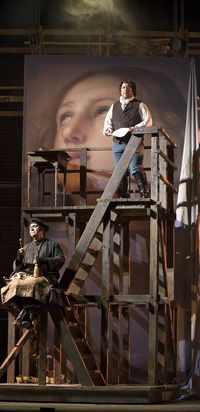
 |
 |
|
||||||||||||||||||||||||||||||||||
|
Dates and Venue 4, 6, 10, 12 April 2013, 8pm (matinée 14 February at 2:30pm) | Royal Theatre, 1815 Blanshard Street, Victoria
Tosca Joni Henson Cavaradossi Luc Robert Scarpia David John Pike Angelotti Alexandre Sylvestre Sacristan Bruce Kelly Spoletta Michel Corbeil Sciarrone Stephen Barradell Conductor Giuseppe Pietraroia Director Amiel Gladstone Production design Christina Poddubiuk Costume designKevin Knight Lighting design Gerald King Stage manager Sarah Robb Sung in Italian with English surtitles Reviewer Elizabeth Paterson When the muses smile, music and acting, direction and design can come together to make an inspired production. Such a blessing fell on POV’s Tosca this month where skill, artistry, intelligence and attention to detail combined to produce an uncommonly satisfying result. In brief, the plot involves characters familiar to us from television to chick-lit: Floria Tosca, both a singer of renown and a high-maintenance diva who does good works; a laid-back artist who gets involved with politics, her lover, Cavaradossi and Scarpia, head of security for the occupying government in Rome, powerful and thoroughly unpleasant . Cavaradossi hides an escaped political prisoner whom he finds in the Church where he is working on a painting. Tosca is sure that Cavaradossi is hiding a woman and her jealous actions inadvertently put Scarpia on the trail. Cavaradossi is captured and tortured but refuses to talk. Scarpia cuts Tosca a deal. He will stop the torture and organize a fake execution to save Cavaradossi’s life if she both tells him where the prisoner is hiding and yields to him. She agrees, but as soon as she can, she stabs Scarpia and kills him. Tosca rushes to tell Cavaradossi he will not die and they can escape, but Scarpia has deceived her. The execution is real. As Scarpia’s men arrive to arrest Tosca for murder she leaps from the battlements of the Castel Sant’Angelo to her death. Luc Robert was a very attractive Cavaradossi. His richly lyrical “Recondita armoni”’ in Act I showed a man of deep affection and drew warm applause from the audience. It paved the way for the achingly lovely "E lucevan le stelle" of Act III as he awaits execution. Joni Henson’s volatile Tosca contrasted with Robert’s quieter demeanour and the two of them worked together very well. “Qual' occhio”, the Act I ‘love duet,’ was a sensuous combination of Robert’s robust chocolate tones and Henson’s sparkling brightness. "Vissi d’arte,” Tosca’s brilliant Act III aria, was an example of beautiful and compelling singing that had the audience’s hugely enthusiastic response. Against these two vividly alive characters, David John Pike’s Scarpio was a cold, cruel, Robespierre-like villain of buttoned-up, contained violence, and all the more threatening for his elegance. His fastidiously clear diction and a strong voice only added to his menace. The smaller parts were also very well sung and acted. Alexandre Sylvestre (Angelotti,), Michel Corbeil as Spoletta, Stephen Barradell’s Sciarrone and particularly Bruce Kelly as Sacristan all made distinct characters of their parts. They were ably supported by members of the POV Chorus and the Victoria Children's Choir. Amiel Gladstone’s direction was sensitive and thoughtful, steering well clear of high-pitched drama but picking up various visual motifs to parallel the score. Where Puccini weaves religious music with his protagonists’ secular concerns, Gladstone gives Scarpio a crucifix to carry in his pocket and uses it to good effect when he lets Tosca find it after the murder. Tosca’s scarf similarly appears and re-appears throughout. These gestures are subtle at first and gradually gain importance. He reserves his bravura moment for the end, when Tosca spectacularly vanishes, centre-stage, before your eyes. The drama unfolds against a subdued set of scaffolding in the dark light of a Roman interior. Period costumes underlined the historical specifics of Puccini’s verismo and silently suggested character in the principal roles. Lighting was by Gerald King and production design by Christina Poddubiuk. Conducted with precision by Giuseppe Pietraroia, the orchestra pulled out all the stops and lushly rose and sank with emotion. Tosca may be a “shabby little shocker” but a first class one that received a first-class production © 2013 Elizabeth Paterson |
|||||||||||||||||||||||||||||||||||